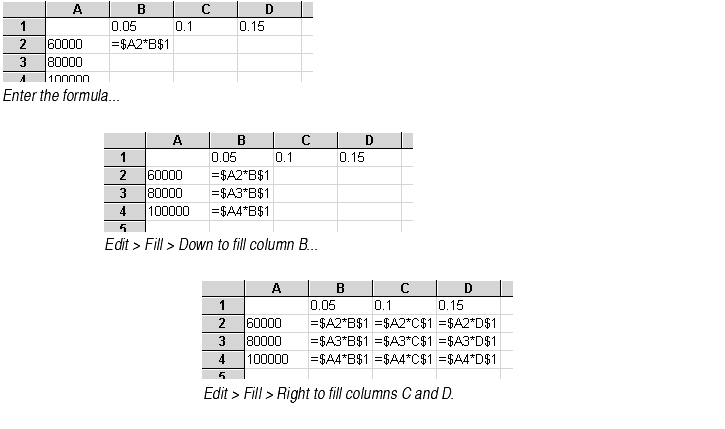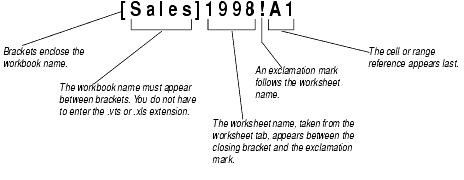In a New Worksheet What Is the Correct Formula to Reference Cell A1 From the Alpha Worksheet
Understanding Cell References
A reference is a cell'south address. It identifies a jail cell or range of cells by referring to the column letter and row number of the prison cell(s). For example, A1 refers to the cell at the intersection of column A and row 1.
The reference tells Formula Ane for Java to use the contents of the referenced cell(south) in the formula. If a formula requires a number, you can substitute a reference to a prison cell that contains a number.
You specify a range of cells past placing a colon (:) between ii cell references. For example, A1:C3 refers to the range anchored by cells A1 and C3. The range includes all cells in columns A, B, and C of rows 1, two, and iii.

Entering Prison cell References
You tin enter cell references in formulas in 3 ways:
- Type in the jail cell or range address.
- Type in the name of a named jail cell or range. For data on defining names, encounter Using Names.
- Employ the mouse to click and elevate on cells and ranges. Formula One for Coffee automatically enters a relative reference identifying the cell(s) you select.
Absolute and Relative References
There are ii types of cell references: relative and absolute.
- Relative references bespeak to a cell based on its position relative to the current cell. When the cell containing the reference is moved or copied, the reference is adjusted to bespeak to a new cell with the same relative offset every bit the originally referenced prison cell.
- For example, suppose the formula
=B1+B2+B3is located in prison cell A1. When you copy the formula and paste it downwardly 2 rows into cell A3, the formula will be adjusted downwards two rows, to=B3+B4+B5. - Relative references will be adapted whenever you cut or re-create and paste a formula or when yous use the Edit > Fill up commands to fill a range with a copy of a formula.
- For example, suppose the formula
- Accented references signal to a jail cell at an verbal location. When a prison cell containing a formula with accented references is moved or copied, the reference does not modify. Absolute references take a dollar sign ($) in forepart of the row number and/or column letter of the alphabet.
References that are part absolute and part relative are called mixed references. The following table lists the reference types.
| Reference | Blazon |
|---|---|
| A1 | Relative reference pointing to cell A1. |
| $A$1 | Absolute reference pointing to cell A1. |
| $A1 | Accented column reference, relative row reference pointing to cell A1. |
| A$one | Relative cavalcade reference, accented row reference pointing to cell A1. |
Using Relative and Absolute References
Yous can copy and paste absolute, relative, and mixed references to create worksheets that are easy to update and that are smaller than worksheets where each formula is created separately.
For instance, in the following worksheet, the values in column A demand to exist multiplied by the percentages in row ane.

To do these calculations, you lot could enter the formula =A2*B1 in cell B2, =A3*B1 in jail cell B3, =A4*B1 in prison cell B4, etc. As well the fact that this would require a lot of typing, this solution would require Formula One for Java to go along nine split formulas in memory.
A better way to practice information technology would be to enter the formula =$A2*B$1 in cell B2, and employ the worksheet'south Edit > Fill control to make full cells B2 through D4 with copies of that formula. When the formula is copied in this manner, its relative references change, only the accented references stay the same.

The resulting worksheet calculates all the figures using multiple copies of that i formula. Only one formula must be kept in retentiveness.

If y'all change the percentages in row 1 or the figures in column A, the calculations in the worksheet volition automatically change considering of the absolute references to those cells. This makes the worksheet easy to update.
References to Other Worksheets
You can reference cells in other worksheets in the aforementioned workbook past placing an exclamation marking betwixt the sheet name and the reference. The sail name is the name found on the worksheet tab. For case, Data!A1 refers to the tiptop left cell in a canvas called Information.
Sheet names with spaces. If the sheet name contains spaces, y'all must enclose the name in unmarried quotes: `1994 sales'!B17.
Cells on two worksheets. You can make a reference to cells on two different worksheets by placing a colon between the ii sail names. For example, Sheet1:Sheet2!A1 refers to two cells: cell A1 in Sheet1 and cell A1 in Sheet2.
Order of canvas names. References to more i worksheet must list the worksheets in the order in which they appear in the workbook.

References to Other Workbooks
References that point to cells on worksheets in other workbooks are called external references.
An external reference is created by placing the workbook name in brackets, followed by the worksheet proper name, an exclamation point, and finally a cell or range reference.

External references volition work only if both workbooks are open in the Workbook Designer. If the referenced workbook is non open when you lot create the external reference, an Invalid Formula Syntax error bulletin will appear.
The post-obit are examples of external references using absolute, relative, and mixed references.
| Reference | Blazon |
|---|---|
| [Sales]1987!A1 | Relative reference pointing to prison cell A1 in a worksheet titled 1987 of a workbook titled Sales. |
| [FY91]January!$A$1 | Absolute reference pointing to prison cell A1 in a worksheet titled January of a workbook titled FY91. |
| [Q1]Sheet1:Sheet2!$A1 | Absolute column reference, relative row reference pointing to cell A1 in the outset and 2nd worksheets of a workbook titled Q1. |
| [Store1]Sheet1:Sheet4!A1:F1 | Relative row and column reference pointing to the range A1 to F1 in the first four worksheets of a workbook titled Store1. |
Paths in External References
After you enter an external reference, Formula One for Coffee will change the format of the reference to evidence the absolute path to the workbook you lot referenced. For example, say you entered this reference to a workbook named September in the Payroll directory on your C bulldoze:
- [September]Payroll!C2:C420
After you enter that reference, if yous return to the cell where the reference was entered, yous will annotation that Formula 1 for Coffee has changed it to:
- `[C:\Payroll\September.vts]Payroll'!C2:C420
This absolute path is recorded in the worksheet. If you later move the September workbook, the external reference should nonetheless piece of work, as long as you lot open September.vts in the Workbook Designer at the same time as the workbook that references it.

Source: https://www.mit.edu/~mbarker/formula1/f1help/04-data6.htm
0 Response to "In a New Worksheet What Is the Correct Formula to Reference Cell A1 From the Alpha Worksheet"
Post a Comment